This is Part 1 of a 3-part series on exercising with hypothyroidism:
- Part 1 – [You Are Here] – How We Helped One Client Lose 17 lbs. By Boosting Her Thyroid with Exercise
- Part 2 – How to Stop Exercise from Ruining Your Thyroid
- Part 3 – Why Exercising More and Eating Less Is the Best Way to Gain Weight with Hypothyroidism
When it comes to hypothyroidism and exercise, you’re kind of damned if you do, and damned if you don’t.
On one hand, you have those who don’t exercise, who are missing out on some serious thyroid-boosting benefits.
On the other hand, you have those who are exercising, who are doing it all wrong, and it’s putting their thyroid in a dangerous position.
It doesn’t take much.
Even one bit of bad advice can ruin any chance of improving your thyroid health when it comes to exercise.
I happen to know this because that’s exactly what happened with a client of mine.
For the sake of privacy, we’ll call her Mary.
When Mary and I first started working together, she was happy with the early progress she was making.
But then something happened…
Mary began to complain that many of her symptoms that had been improving were back with a vengeance.
Almost all of the progress we had made over those two months disappeared over a two-week timeframe.
As It turned out, since Mary was feeling better and had more energy, she decided to join a gym and start exercising again, thinking it would help her lose weight faster.
Boy, was she wrong… and now she was paying the price.
We came to find out that almost everything we were doing to fix her thyroid was being negated by her poor exercise choices.
Now, I don’t believe in discouraging anyone from exercising.
But, when it comes to hypothyroidism and exercise, I do believe in teaching thyroid sufferers how to use exercise safely and effectively to boost thyroid function.
In fact, due to the needs of my clients and my exercise-science background, I developed my own thyroid exercise system to do just that.
So, I explained the dangers of her current exercise routine and set her up with an exercise program designed specifically for thyroid sufferers.
After that, we monitored her for another three months and here’s what we found…
- 3 Week Results: The returning thyroid symptoms were subsiding while the welcomed initial improvements returned.
- 6 Week Results: There were noticeable changes in body composition. Other noticeable changes included improved blood sugar handling, increased energy, more consistent energy, decreased edema, increased average daily body temperature, and improved exercise endurance.
- 12 Week Results: Continued improvement in energy, symptoms, and general well-being. Noticeable increase in lean muscle combined with reduced fat and water-weight (distributed evenly across body), accounting for a 17 lb. (7.7 kg) weight-loss total. Improved average daily body temperature held steady, just slightly below normal (98.6 ºF / 37 ºC).
Here are 3 ways we transformed this client’s dangerous thyroid-suppressive exercise routine into one that protected and boosted her thyroid function to help achieve these results.
1. We Made Sure She Was Exercising ONLY Within the Thyroid-Supportive Energy System
Everyone understands the idea that food can by “healthy” or “unhealthy”.
Yet, few understand that the same goes for exercise.
Exercise can be quite “unhealthy” for you if you’re hypothyroid (or even when you’re not).
So, it’s essential that you exercise in a way that’s “healthy” for your thyroid.
One way to do this, which I did with this client, is to exercise within what I like to call the “Thyroid-Supportive Energy System”.
Your body depends on many energy systems to meet the high energy-demands of exercise.
Some are safer and thyroid-supportive, while others are dangerous and thyroid-suppressive.
You can see a graph of these energy systems below based on the length of time your body is required to produce constant high energy-demands without rest.
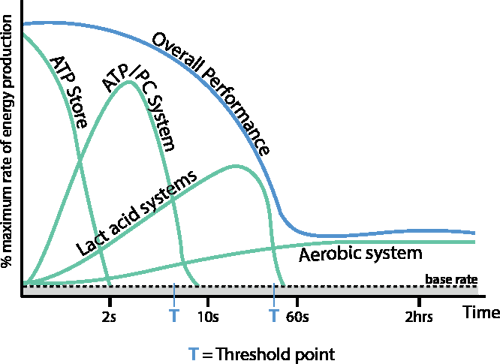
Ideally, you need to exercise within the ATP/PC Energy System (or as we call it, “Thyroid-Supportive Energy System”).
This means not putting your body under high energy-demand for longer than 8 to 10 seconds at a time without taking a break to allow your ATP energy reserves to replenish.
If you continue to place high-energy demands on your body for longer than this, then your stored energy reserves become depleted.
And you push yourself into the dangerous, and thyroid-suppressive, lactic acid and aerobic energy systems.
I talk more about how to avoid these dangerous thyroid-suppressive exercise energy systems in this post on “How to Stop Exercise from Ruining Your Thyroid”.
If you want to learn the only safe and effective way to boost your thyroid with exercise, then this “Thyroid Energy System Training” technique is essential, which is why we cover it extensively in our Hypothyroidism Exercise training.
You can get all the details about this Hypothyroidism Exercise training by clicking here.
That covers the first step of the process of how we fixed this client’s exercise routine.
Yet, don’t underestimate the importance of these next two steps, which are just as vital…
2. We Took Advantage of Her “Metabolic Exercise Window”


Imagine that there’s a brief magical window of time every day.
And if you eat certain thyroid-boosting foods during this window, their thyroid-boosting effects are amplified 3X, 5X, or even 10X.
Who wouldn’t want to take advantage of that?
That’s sort of what your Metabolic Exercise Window is like.
When you exercise, research shows that your cells become hyper-sensitive to certain thyroid-boosting foods, allowing them to have a much greater impact on your thyroid health.
This helps improve many aspects of thyroid function including:
- Increasing Active T3 Hormone Production
- Restoring Liver and Muscle Glycogen
- Improving Blood-Sugar Regulation
- Increasing Healthy Muscle Production
- And more…
Yet, get this…
These effects don’t just last “during” this special window of time… these thyroid-boosting effects continue long after your workout is over.
Getting back to our client, I designed a special drink and simple exercise-nutrition plan for her to use prior to her workouts, during her workouts, and then immediately after her workouts to take advantage of her Metabolic Exercise Window.
This window only lasts up to about 45 minutes after your workout.
So, it’s extremely important to get adequate nutrition that is quickly and easily absorbed before the window closes.
This Metabolic Exercise Window is something that very few thyroid sufferers use to their advantage.
Instead, most are given the horrible advice to avoid food anytime near when they exercise.
I talk more about the necessity of exercise-nutrition in this post on “Why Exercising More and Eating Less Is the Best Way to Gain Weight”, which is a trap that so many thyroid sufferers fall into.
This Metabolic Exercise Window isn’t only important for boosting your thyroid function.
It’s essential to make your exercise safe and productive, rather than harmful and counterproductive.
And it can make all the difference with what I’m going to show you next.
3. We Tested (and Never Assumed) That Each Workout Was Helpful (NOT Harmful) to Her Thyroid
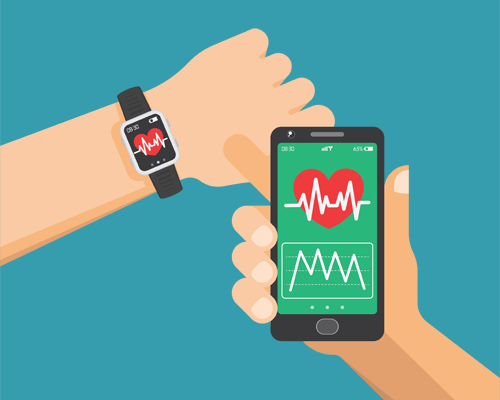

Another common mistake I find among clients and thyroid sufferers is “assuming” that all exercise is safe and effective.
Maybe you’ve heard the saying “When you ‘ass-u-me’, you make an ‘ass’ out of ‘u’ and ‘me’…” (clever, right?)
Well, I don’t know about you, but I was taught never to “assume” anything.
We’ve already established above that not all exercise is “healthy”.
Yet, wouldn’t it be nice if you could slap a monitor on your wrist and have it alert you if your workout becomes dangerous?
Unfortunately, technology isn’t that advanced yet.
However, you can still effectively test yourself to ensure that your workouts are safe and effective.
Sure, there are symptomatic responses of a harmful workout that you can look for (and I do recommend you do), including:
- Feeling more tired or exhausted after your workout
- Difficulty catching your breath
- Severe muscle fatigue
- Lightheadedness
- Etc.
Yet, I’m referring to testing measurable physiological responses, like your body temperature and pulse.
This is exactly what we did with our client.
We had her measure her body temperature and pulse before and after her workouts to test whether her workout was helpful or harmful.
Doing this, we could tell if she was pushing herself too hard.
Or, if she was ready to progress to the next phase of her exercise program.
This allowed us to adjust her workouts (and nutrition) to meet her specific needs.
This specific feedback made all the difference for this client because she could determine exactly how much exercise, and how long, her body (and thyroid) could tolerate.
If you’re interested in learning more about the specifics of this thyroid-exercise testing method, I talk about it in more detail in this post on about “How to Stop Exercise from Ruining Your Thyroid”.
Many of the roadblocks we faced with this client were caused because this client assumed all exercise is safe and effective for thyroid sufferers.
That’s just not the case when it comes to hypothyroidism and exercise.
After discussing this with so many clients, I can say that almost all who are exercising without proper guidance are only causing themselves (and their thyroid) more harm.
Yet, by making these three simple changes to our clients’ exercise routines, we’ve been able to eliminate these roadblocks and use exercise to our advantage in helping to restore healthy thyroid function.
If you want to learn the only safe and effective way to boost your thyroid with exercise, then this “Thyroid Energy System Training” technique is essential, which is why we cover it extensively in our Hypothyroidism Exercise training.
You can get all the details about this Hypothyroidism Exercise training by clicking here.


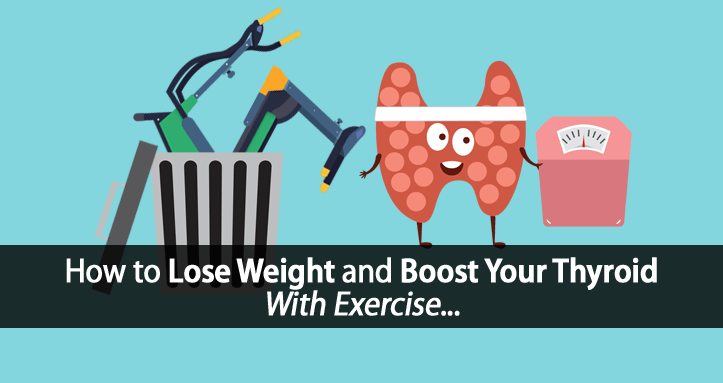
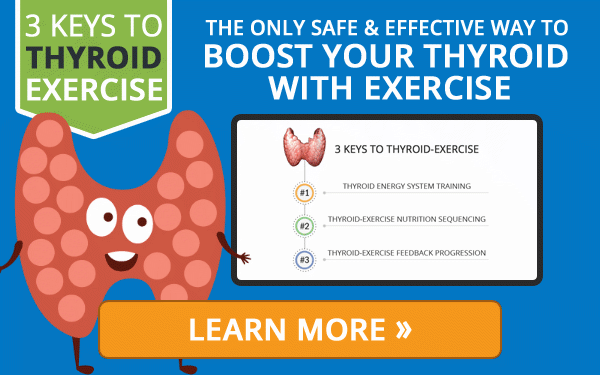
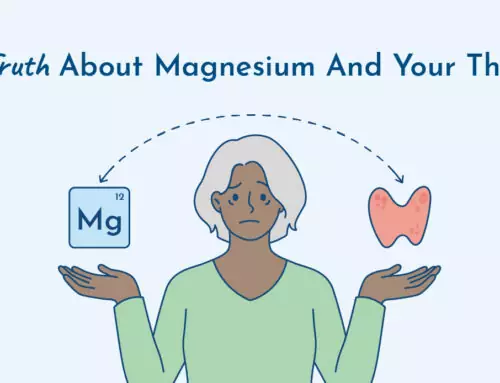


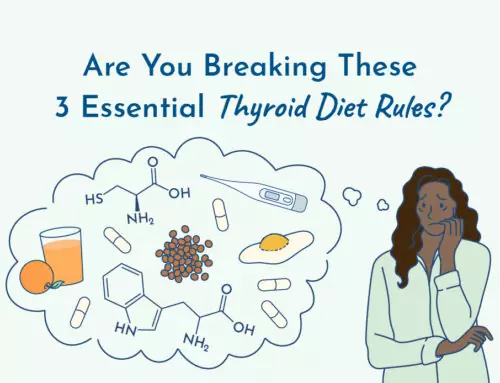
I have no thyroid due to thyroid cancer what can I do?
90% removed during surgery and then cyomel for 7 weeks
then I-131 TREATMENT
Hi Mary, here’s another article where we’ve discussed thyroidectomy in more detail: https://www.forefronthealth.com/rai-and-thyroidectomy/
Would you care to share more info about the special drink and nutrition during and after the exercise?